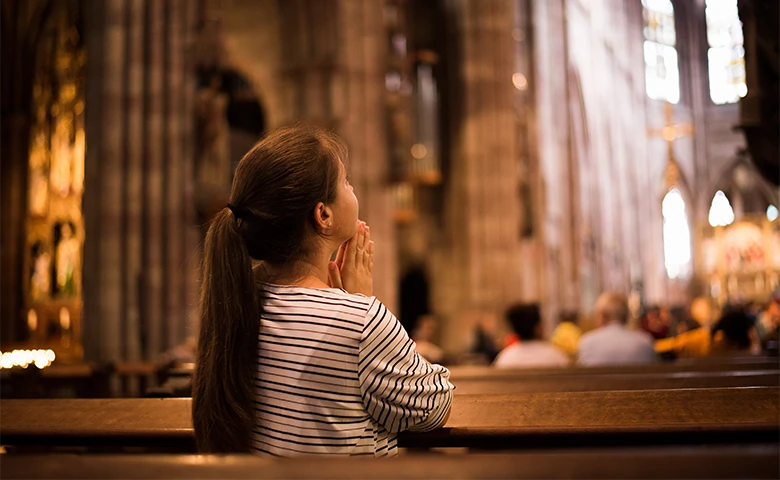

Minicat
Solemnity of the Sacred Heart of Jesus
Every year, nine days after the Feast of Corpus Christi, the Church celebrates the Solemnity of the Sacred Heart of Jesus.
Every year, nine days after the Feast of Corpus Christi, the Church celebrates the Solemnity of the Sacred Heart of Jesus. This feast has an inconceivably great significance, which becomes even more deeply visible against the background of the Corona crisis. For we, the people of the 21st century, it contains valuable promises.
The feast goes back to apparitions of Jesus to the now canonised nun Mary Margaret Alacoque of Paray-le-Monial, to whom Jesus appeared in the 16th century and said: “I promise everyone who confesses nine months in a row on the first Friday of the month and receives Holy Communion in reparation for all the sins committed against my Sacred Heart, that he will die penitent, not without receiving the Holy Sacraments. My Sacred Heart will be his safe refuge at the hour of his death.”
Jesus is faithful
I used to think, well, I wonder if Jesus really keeps that promise? It seems so grand. I’ve thought to myself, with this promise in a time like this, where many people have had to die without a priest at their bedside – isn’t it something great to know that Jesus promises us this and he is faithful to his word. In fact, at the end I will tell a story about an Italian man to whom Jesus proved in an unsurpassable way that he is faithful to this promise. But for now, let’s stick with the feast itself.
First, there is the promise to all who confess and receive communion on the first Friday for nine consecutive months that they will not die without receiving the sacraments: and we cannot wish for anything greater or more important for the hour of our death. Secondly, Jesus said that he wished a feast to be instituted for the veneration of his Sacred Heart, this feast is to be celebrated exactly nine days after Corpus Christi.
Why nine days after Corpus Christi?
Because this feast is a profoundly Eucharistic feast. Because the veneration of the Sacred Heart is about venerating the innermost centre of the heart, of God made man. That is, the heart from whose opened wound on the cross, blood and water flowed as a source of mercy for all humanity. Think of Jesus’ message to Sister Faustina Kowalska: No matter how great man’s sin, if he takes refuge in the Heart of Jesus, in His mercy, God will grant him mercy and through this blood and water create a new man. Forgiveness is nothing other than new life from death.
Why is the feast Eucharistic?
In the Eucharist, the heart of Jesus remains physically, i.e. bodily present for us until his return. God shows this again and again in a special way in the so-called Eucharistic miracles. We encountered such a miracle in the first millennium in Lanciano, Italy, where the Eucharist was transformed into flesh and blood during the consecration in the hands of a monk who doubted the Real Presence. It can still be seen and venerated today – 1000 years later. But this miracle did not just happen 1000 years ago, it has been repeated many times and in different places around the world throughout the history of the Church. In 2016 it happened in Liegnitz, Poland. Interestingly, it has become scientifically verifiable thanks to modern technological advances. In Poland, the host fell to the ground. When that happens, one usually puts the host in water, because once the bread dissolves, it ceases to have the form of bread and then Jesus ceases to be bodily present — because his bodily presence is tied to the form of bread. One does this out of respect for the Lord. In this case, however, the bread did not dissolve, but it turned into a piece of flesh. This flesh was later subjected to scientific examination, which revealed that it was the flesh of the heart of a person living today in the agony of death. (To be read here: https://www.tag-des-herrn.de/content/eucharistisches-wunder)
The Eucharist, then, is the heart of Jesus in the agony of the cross.
Here we see Jesus’ intention in instituting the Eucharist: he wanted to keep present among us the sacrifice of his suffering, so that all may have recourse to this sacrifice of His and receive forgiveness of their sins from this sacrifice. The Eucharist, which we normally only see as a piece of bread, is in fact the heart of Jesus himself and the heart is a symbol of the whole person. He is present in humanity and divinity.
In the apparition to Margaret Mary Alacoque, Jesus expressed his desire that a feast be instituted in honour of His Sacred Heart and that on this feast we receive Holy Communion in reparation (i.e. atonement) for all the injuries inflicted on Jesus. Pope Pius IX finally elevated this feast, which had already been celebrated sporadically throughout the world, to a feast for the whole Church in 1856.
Jesus said the following to Saint Margaret Mary:
See here the heart that loved people so much, that did not spare itself, but gave itself completely and consumed itself to prove its love to them. For the reward I reap from most is only ingratitude, coldness and disregard, which they inflict on me in the sacrament of love. Therefore, I demand that on the first Friday after the Octave of Corpus Christi, a special feast be instituted for the veneration of my Sacred Heart.
One should receive Communion on that day and thereby make reparation for all the wounds inflicted on the Heart of Jesus. What are these wounds in the Heart of Jesus? It is our ingratitude, it is the spurning of his love, it is the indifference we have towards him and the fact that many Christians, even though he died for us on the cross and even though he longs to come to us in Holy Communion every Sunday, let our dear Lord be nothing more than a good man and think they can do without him.
Anyone who has ever had heartbreak knows how painful it is; they know what Jesus suffers all the time and understand a little why Jesus even died of this heartbreak in the end.
God loves us with a human heart.
To make amends, Jesus desires nothing but an act of love. No scourging, no fasting, even if he desires fasting in other respects. But to make amends for the injuries of his love, he desires nothing else than that we love him all the more. And how does one love Jesus most? By going and receiving Jesus and his love in the Eucharist.
Now for the promised example from Italy:
In the last century there lived in Rome a man called Bruno Cornacchiola who had bought a sword during the Spanish Civil War because someone had convinced him that the Pope was the Antichrist and that all the misfortune of humanity was only because there was a Pope and the Catholic Church. To do something good for the world, he had been told, he should kill the Pope. This was his goal from then on. He came back to Rome from the civil war and said to his wife, “We are leaving the Catholic Church at once because it is the greatest evil there is.” His wife begged him not to, but after he beat and maltreated her she finally gave in. However, on the condition that they celebrated the nine Fridays of the Sacred Heart together beforehand.
As soon as this condition was fulfilled, Bruno said to her: “I have kept my part of the deal and now you keep yours, we are leaving the Church.” He then became a famous rabble-rouser against the Catholic Church and all its teachings. One day he was near Trefontane with his children, preparing a sermon to prove that Mary was not the Immaculate Conception. Suddenly his children had disappeared. He started looking for them and found them kneeling in a grotto, although he had strictly forbidden them to ever kneel. He shouted at them, “I have forbidden you, quickly, we must go home!”. The children did not react, they were completely absent. He took his three-year-old child and tried to pick him up from the ground, but the child was as heavy as a thousand tons, he could not pick him up from the ground.
God leads people back to his sheepfold.
In desperation he suddenly cried out, “God, help me!” Then his eyes opened and before him stood Our Lady with a Bible in her hand. A long dialogue followed and Our Lady finally said to him: “Jesus is faithful to his promises. Because your dear wife has kept with you these nine Fridays of the Sacred Heart, God has now been able to give you the grace that I have been sent to you to restore you to the true faith, to call you back to the sheepfold of my Son and to tell you that you will die a penitent death.” Thank God he did not die immediately but in 2001, had special prophetic gifts, was very close to all the popes until his death and even advised them.
{You can find this on Google under the title “Marian apparitions Trefontane”, the seer Bruno said very exciting things about our times. More about that another time}.

YOUCAT Digital
Discover our digital products, which will help you to grow in faith and become missionaries yourself.





